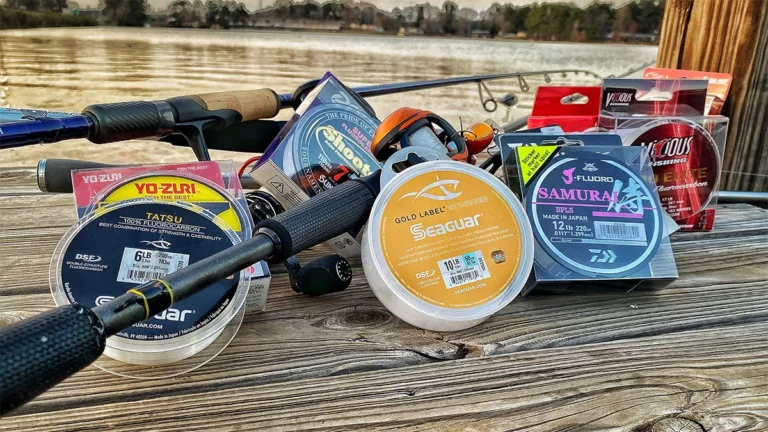Do you know what line is best for each situation?

Fishing lines are an essential component of any fishing outfit. There are different types of fishing lines available in the UK, each with its unique strengths and weaknesses. Understanding the different types of fishing lines and what they are used for will help you make the right choice of a line for your fishing needs. This guide will walk you through the most common types of fishing lines in the UK, including monofilament, braid, pre-stretched monos, and fluorocarbon.
1. Monofilament
Monofilament fishing lines, commonly known as mono, are the most popular type of fishing lines in the UK. They are made from a single strand of nylon, although nowadays, they are available in different materials such as copolymer and fluorocarbon. Monofilament fishing lines have been in use for over a century and are still widely used because of their versatility.
Strengths:
Monofilament fishing lines have a lot of stretch, which makes them perfect for fighting fish that make sudden and jerky movements. The stretch also helps to cushion the initial shock of the hookup, reducing the risk of the line breaking. Mono lines are also cost-effective and readily available, making them an excellent option for beginners and anglers on a budget. These are very popular for shock leaders and snood mono for sea fishing.
Weaknesses:
One of the significant drawbacks of monofilament lines is their low abrasion resistance, which makes them susceptible to wear and tear. This means that they are more likely to break when they come into contact with rocks or other sharp objects. They also have a high memory, which means that they tend to retain the shape of the spool they have been wound on, resulting in line twists and tangles. Mono lines also degrade over time and will need to be replaced every few months.
Uses:
Monofilament lines are widely used in various fishing applications, including freshwater and saltwater fishing. They are perfect for casting and trolling, and they are a popular choice for bait fishing.
2. Braid
Braided fishing lines are made by weaving together multiple strands of synthetic fibers such as Spectra, Dyneema, or Kevlar. These fibers are thin and strong, resulting in a fishing line that is incredibly durable and resistant to wear and tear.
Strengths:
Braid fishing lines have very little stretch, making them incredibly sensitive to the slightest bite. This means that you can feel everything that is happening under the water, allowing you to detect even the slightest movement of the fish. They also have high tensile strength, making them perfect for hauling in big fish. They are also very durable and can withstand the rigors of saltwater fishing without degradation. They are also much thinner in breaking strain which allows you to cast further.
Weaknesses:
Braid fishing lines are visible in the water, making them less effective in clear water conditions. They also tend to pick up debris such as weeds and sticks, resulting in tangles and knots. Braid fishing lines are also more expensive than monofilament lines, making them less accessible to beginners.
Uses:
Braid fishing lines are generally used for saltwater fishing and are perfect for bottom fishing, jigging, and fly-lining. They are also used in freshwater fishing for casting and trolling.
3. Pre-stretched monos
Pre-stretched monofilament fishing lines are manufactured using a proprietary stretching process that ensures that the lines are pre-stretched, resulting in a line that has lower stretch than regular monofilament lines.
Strengths:
Pre-stretched monofilament fishing lines have the same sensitivity as braided lines, making them perfect for detecting even the slightest bite. However, they have more stretch than braid, making them more forgiving when fighting fish. They also have a high abrasion resistance, making them perfect for fishing in rough conditions.
Weaknesses:
Pre-stretched monofilament fishing lines are more expensive than regular monofilament lines and have the same visibility problem as braided lines.
Uses:
Pre-stretched monofilament fishing lines are perfect for fishing in rough conditions, including rocks, weeds, and debris. They are also suitable for trolling and bait fishing.
4. Fluorocarbon
Fluorocarbon fishing lines are made from a mixture of fluorocarbon compounds that make the line virtually invisible underwater.
Strengths:
Fluorocarbon fishing lines are almost invisible underwater, making them perfect for fishing in clear water conditions. They also have a greater abrasion resistance than monofilament lines, making them more resistant to wear and tear.
Weaknesses:
Fluorocarbon fishing lines have very little stretch, making them less forgiving when fighting fish. They also tend to be more expensive than monofilament lines.
Uses:
Fluorocarbon fishing lines are perfect for fishing in clear water conditions, including saltwater flats, freshwater rivers, and trout streams. They are best suited for bottom fishing, trolling, and casting.
Conclusion
Choosing the right fishing line can be challenging, given the different types available in the UK. Consider the fishing location, style, and species of fish you will be targeting to determine the best type of fishing line for your needs. Monofilament fishing lines are perfect for beginners and general-purpose fishing, while braid and pre-stretched mono lines are ideal for saltwater fishing. Fluorocarbon fishing lines are perfect for fishing in clear water conditions. Whatever line you choose, make sure to handle it with care and store it properly to ensure its longevity. Happy fishing!
